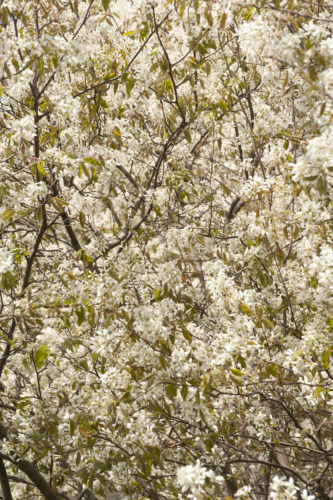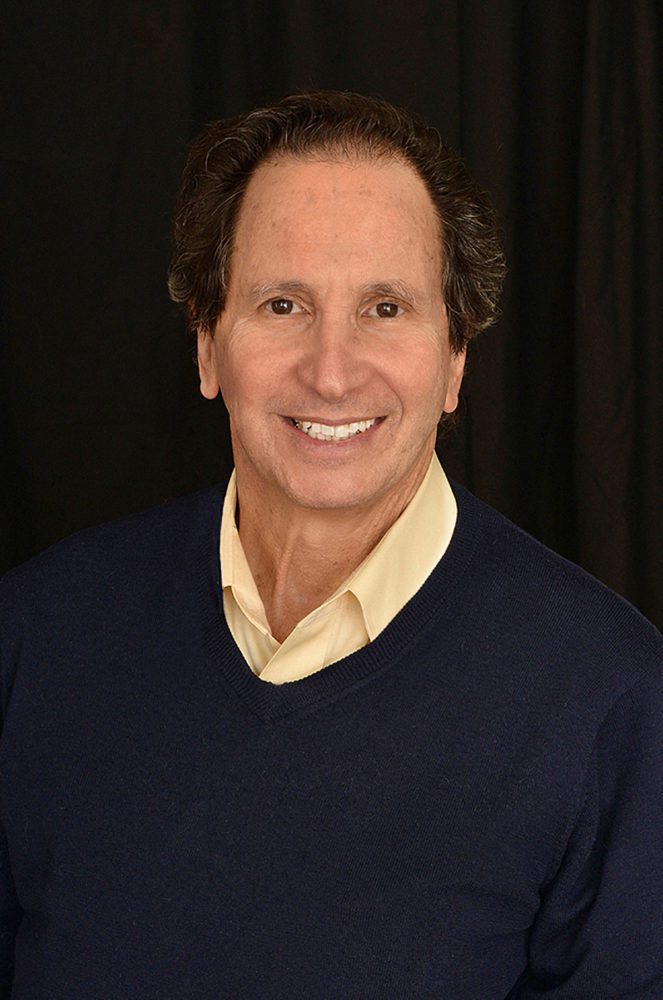The Legend of the Service Tree
Poetry of Everyday Life Blogpost #9

“We grew up thinking that if there wasn’t pavement under our feet, we were lost,” Marc Kaminsky said facetiously, as he sat with his longtime friend George Getzel, who lay dying in a hospital bed at Calvary Hospital in the Bronx, talking about spring. They were two Bronx kids who morphed into two aging, brilliant intellectuals. They knew each other from their time at Hunter College School of Social Work in the ’70s. Struck by George’s tranquility in the face of mortality, Marc asked his friend, filmmaker Menacham Daum to videotape their conversation, and sent a copy to me.
In his better days, George told Marc, he’d loved to visit the New York Botanical Garden in all four seasons. Each time it would be a totally different world—the garden was a symbol of nature and birth and growth and decay.
“You discover this natural world,” Marc remarked. “You take this literal fact and use it as a symbol of immortal life.”
“I was especially close to the service tree,” George continued. “It’s an indigenous tree in northeast America. It’s a tree that’s barely a tree—it might be considered a bush—but it’s a tree. It actually fruits, it has a sweet little fruit that comes out of it when spring warms up, but it’s the first tree that blossoms in the woods. It has soft, large flower petals, light pinkish-white, and if you can reach out and smell it, the tree has the most delicate perfume—really beautiful. It only blooms when the earth around it is unfrozen.

“Our ancestors—at least the ones in North America—had a real problem when people died during the winter, because they couldn’t bury them; the ground was too hard. So what they did was wait till the service tree bloomed, and then they knew they could bury the dead because the ground was soft enough. Otherwise the bodies would have to be kept in coffins stacked in barns. That touched me deeply.
“So for the last few years, when I could still walk, I’d been trying to hit one of my holy places—the service tree. I would go into the Bronx botanical garden to walk on a trail through fifty acres of virgin forest that had never been cut, and there is the service tree, and I try—it has a life of flowering of, like, three days—so I always try to imagine, ‘Is the ground soft?’ ‘Will I make it?’ And sometimes I make it and sometimes I don’t, and the service tree’s spent flowers are on the ground, but I think that it is emblematic of my notion of immortality in life: a brief time, a beautiful fragrance, and then passing, disintegrating, falling to the ground, and renewal.”
Alone with his mortality in the hospital late one night, George spontaneously texted Marc some of his spiritual musings. Marc later lined the text out as a poem. It ended
Humankind calls out for compassion
For one’s self and then the other
The spent perfume of the petals
Of the service tree
Fall to the forest bottom
When earth loses its chill
“The last four lines” Marc told him, “sound like the poem that Zen priests wrote just before they died.” It was as if George were musing about an eternal spring, with ground soft enough to accept his body, a universe that still had a place for him even after his death.

“So here I am in bed, and I’m fading away, I’m losing weight, there are changes, and people visit me and they say, ‘I really want to go to the botanical gardens with you,’ and then a little sadness comes over me—’cause that’s not possible anymore.”
George was a faculty member at the Hunter College School of Social Work, now the Silberman School of Social Work for more than 30 years. As someone who avoided the limelight, he wouldn’t have wanted anyone to walk in his footsteps. “If anything I do is truly worthwhile in my eyes or in the world’s eyes, I don’t want to be copied,” he said. “I just don’t want it—I’m me, you’re you. But I do want to inspire.”
And so as spring rolls around after a bitter winter, I was inspired to call the New York Botanical Garden in the Bronx and ask if they knew about the service tree. The Garden arranged for horticulturalist Jessica Schuler, Director of the Thain Family Forest, to meet my wife and me at the reflecting pool the next Saturday. We traveled into the woods she knew so well and we stood in front of the tree George had loved. Though it was the first beautiful day of spring, the service tree had just a tiny splash of pink on the buds. Perhaps the ground wasn’t yet soft enough to bury the dead.

I told Jessica about George, whom I never met, and his metaphorical interpretation of the service tree. Jessica told us the tree’s Latin name was Amelanchier arborea but that it had had a variety of common names and etymologies in early North America. Shadbush because it often grows in riparian forests at the edges of rivers where the shad run. It was also called “Juneberry,” because it often fruited in June. And it was called “serviceberry tree,” because it bloomed when the ground was no longer frozen and it was time to bury the dead and hold a service.
Back in the hospital room, Marc felt that the space around himself and George was getting greater and greater, and that on the other side of that space was death, but that the space of life was also looming larger. George continued to express his deep and thoughtful perspective on life in the face of imminent mortality, making connections between blossoming and withering, growth and decay. “I remember holding my wife’s hand when she was dying,” George told Marc, “and having a great sense of intimacy, the same as when I held my hand over her belly when she was pregnant. There’s this mixture. Even in the face of the grim realities of life that nauseate you and shatter your dreams, I’ve found—with difficulty—deeper meaning.
“We all hold down to something that we would hope would have permanence,” he continued. “Something that would lead us beyond our grave and have something of eternity tied to it. We discover that the idol—be it money, position, your own children, the neighborhood you live in—it’s not forever and it falls apart and isn’t what you thought it was when you were a young man. It becomes moth-eaten and dissipates, and then with that—and here is where I think the faith of an older person, the circumstance of an older person, is useful—it’s followed by new growth, new possibilities.”
George Getzel died on January 7, 2018.
The serviceberry tree he loved so well will bloom again this spring.







6 thoughts on “Spring Burial”
Steve & Amanda, This is such a beautiful and poetic story. Thank you for the beauty and inspiration and for passing along knowledge from many generations. Audrey
A loving, very moving tribute to a friend. Thank you,
Marc; thank you, Steve.
A loving, moving tribute to a friend. Thank you, Marc . Thank you, Steve.
Hi Steve, This is so rich, so poignant, so down to earth, and yet so profound. I am reminded of a favorite scripture which is from Isaiah 40:8 – “The grass withers and the flower fades, but the word of God shall stand forever.” It was my mother’s favorite as well and is engraved on her tombstone. The service tree has special meaning as my Mama died in frozen January. The Bronx Botanical Garden also has special meaning in our family as my younger daughter Sara studied horticulture therapy in this magnificent setting. Thank you Steve, this tale is really a treasure. Sharon Regan, Boston
Thank you so much for “Spring Burial.” I read it with a particular kind of amazement: the depth and beauty of George’s spontaneous utterance are signs of the spiritual power that are at once rare and a wide possession among human beings, and are continuous with the sense of revelation that uplifts the soul when we hear the sages of the various traditions address us. George’s incarnation of symbols that link death and immortality includes his listeners n a conversation that includes Jesus, the hasidic masters, the Buddha…Your retracing his footsteps and seeking a guide to take you to the service tree
is a pilgrimage and a generous act of witness.
Love,
Marc
The writer of the story is very sensitive. He obviously understands the poetry of everyday life and death.